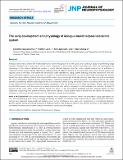Files in this item
The early development and physiology of Xenopus laevis tadpole lateral line system
Item metadata
| dc.contributor.author | Saccomanno, Valentina | |
| dc.contributor.author | Love, Heather M | |
| dc.contributor.author | Sylvester, Amy L | |
| dc.contributor.author | Li, Wen-Chang | |
| dc.date.accessioned | 2021-11-19T11:30:11Z | |
| dc.date.available | 2021-11-19T11:30:11Z | |
| dc.date.issued | 2021-11-17 | |
| dc.identifier | 276614249 | |
| dc.identifier | 035502bf-c0d7-4428-a004-a86366e22d5f | |
| dc.identifier | 34705593 | |
| dc.identifier | 85120043157 | |
| dc.identifier | 000728489800007 | |
| dc.identifier.citation | Saccomanno , V , Love , H M , Sylvester , A L & Li , W-C 2021 , ' The early development and physiology of Xenopus laevis tadpole lateral line system ' , Journal of Neurophysiology , vol. 126 , no. 5 , pp. 1814-1830 . https://doi.org/10.1152/jn.00618.2020 | en |
| dc.identifier.issn | 0022-3077 | |
| dc.identifier.other | RIS: urn:484C2115533A2D792FB214A73C4955AA | |
| dc.identifier.other | ORCID: /0000-0002-1179-6636/work/103137651 | |
| dc.identifier.uri | https://hdl.handle.net/10023/24372 | |
| dc.description | Valentina Saccomanno was an exchange MSc student in the University of St Andrews with a scholarship by the Erasmus+ Programme for Traineeship and the University of Trieste. This project was partly supported by a BBSRC grant (BB/T003146). | en |
| dc.description.abstract | Xenopus laevis has a lateral line mechanosensory system throughout its full life cycle, and a previous study on prefeeding stage tadpoles revealed that it may play a role in motor responses to both water suction and water jets. Here, we investigated the physiology of the anterior lateral line system in newly hatched tadpoles and the motor outputs induced by its activation in response to brief suction stimuli. High-speed videoing showed tadpoles tended to turn and swim away when strong suction was applied close to the head. The lateral line neuromasts were revealed by using DASPEI staining, and their inactivation with neomycin eliminated tadpole motor responses to suction. In immobilized preparations, suction or electrically stimulating the anterior lateral line nerve reliably initiated swimming but the motor nerve discharges implicating turning was observed only occasionally. The same stimulation applied during ongoing fictive swimming produced a halting response. The anterior lateral line nerve showed spontaneous afferent discharges at rest and increased activity during stimulation. Efferent activities were only recorded during tadpole fictive swimming and were largely synchronous with the ipsilateral motor nerve discharges. Finally, calcium imaging identified neurons with fluorescence increase time-locked with suction stimulation in the hindbrain and midbrain. A cluster of neurons at the entry point of the anterior lateral line nerve in the dorsolateral hindbrain had the shortest latency in their responses, supporting their potential sensory interneuron identity. Future studies need to reveal how the lateral line sensory information is processed by the central circuit to determine tadpole motor behavior. | |
| dc.format.extent | 17 | |
| dc.format.extent | 5999732 | |
| dc.language.iso | eng | |
| dc.relation.ispartof | Journal of Neurophysiology | en |
| dc.subject | Lateral line | en |
| dc.subject | Xenopus laevis | en |
| dc.subject | Tadpole | en |
| dc.subject | Hindbrain | en |
| dc.subject | Afferent | en |
| dc.subject | QH301 Biology | en |
| dc.subject | DAS | en |
| dc.subject.lcc | QH301 | en |
| dc.title | The early development and physiology of Xenopus laevis tadpole lateral line system | en |
| dc.type | Journal article | en |
| dc.contributor.institution | University of St Andrews. School of Psychology and Neuroscience | en |
| dc.contributor.institution | University of St Andrews. Institute of Behavioural and Neural Sciences | en |
| dc.identifier.doi | 10.1152/jn.00618.2020 | |
| dc.description.status | Peer reviewed | en |
This item appears in the following Collection(s)
Items in the St Andrews Research Repository are protected by copyright, with all rights reserved, unless otherwise indicated.

